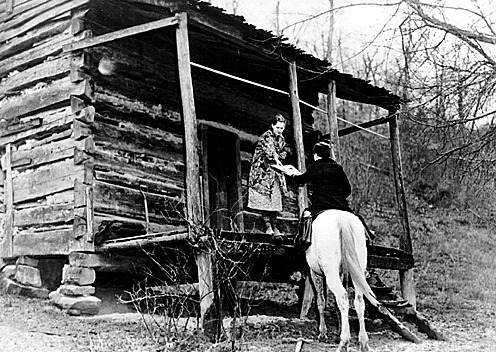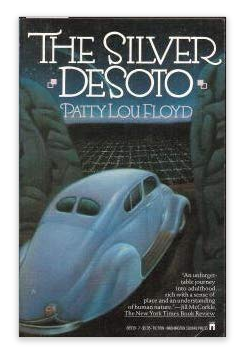Once again my friend Theresa has steered me to a book I have found fascinating and can recommend wholeheartedly: The Last List of Miss Judith Kratt by Andrea Bobotis. The story is set in Bound, South Carolina, in the present-day with narrator Judith Kratt, 75, harkening back to her youth in memory to give readers the complete story.
If I am pressed, I will admit that Southern authors are my favorites. In no particular order, Eudora Welty, William Faulkner, Zora Neale Hurston, Flannery O’Connor, Walker Percy, Carson McCullers, Margaret Mitchell, Alice Walker, and Kate Chopin come quickly to mind. These authors tell stories that remind me of family stories and of the way of telling the story. Rarely straightforward, each story ambles on its way with tidbits thrown in to explain or further enhance the main story. Or sometimes to go completely off track onto another path only to wander back to the original story after all.
Jim Hartz interviewed Eudora Welty for the Today Show on 6 Feb 1976. Welty “describes growing up in a culture that ‘relished’ storytelling.” She further explained that “growing up in Mississippi, in Jackson, is good for any writer because we are a nation of talkers, listeners, and storytellers. And when you live in a small town where you know everybody you get it all.” She continues by saying storytelling is “unique to the South maybe.” She hedges a bit there, but we know Southerners do love telling stories. Of course, other areas of the country and other cultures do too.
Pat Conroy, a South Carolina native, weighed in on Southern storytellers: “Every region has their oddballs, for sure. But in the South, we embrace our oddballs and listen to their tales.”
My heart is still pounding fifteen minutes after finishing the last page of The Last List of Miss Judith Kratt. While I will not include spoilers, it will not surprise readers to learn that long-kept family secrets will come to light as Miss Judith faces the past her family has lived.
Having grown up in a very small town populated with many of my relatives, I am aware of secrets long-held. One of those family secrets came to light last year when I had my DNA analyzed through Ancestry.com. I discovered my cousin’s daughter who had been adopted at birth sixty years ago in a closed adoption. That discovery resulted a cousins’ family reunion and an opportunity to meet our newly-found cousin. Sadly, her mother has died, but she did get to meet her two aunts and a whole passel of cousins.
This review will include no spoilers. Let me say, though, that I hate Daddy Kratt even though he was long dead when the story opens. He is a thoroughly despicable character and I still feel a visceral hatred and repulsion when I think of him. He is the archetypal bully, villain, and miscreant all rolled into one person. Caring only for himself and what he can amass in money and goods, Daddy Kratt rolled over everyone and everything in his path exactly like a bulldozer without caring about the consequences as long as he got what he wanted.
And Daddy Kratt succeeded—for a time. He owned cotton gins, many acres of land, a fine home, a store, and a gas station. He even pushed Mr. Delour, his own father-in-law into bankruptcy and never looked back. Mr. Delour had mentored Daddy Kratt when Daddy Kratt was a young man working toward amassing his fortune. None of that means a thing to a miscreant, however.
In the present-day, Judith lives in the family home, now in some disrepair as fortunes have fallen long ago, with Olva, a Black woman only slightly older than Judith. The two have been together all their lives. Judith’s brother Quincey, age 14, died from “a fatal gunshot to his person in the early hours of Friday, December 20, 1929.” This news is related to readers at the beginning of the book.
Then Bobotis works backward and forward to complete the story. Judith and Quincey’s younger sister is Rosemarie, named for their mother, also Rosemarie. Other important characters include Dee, Rosemarie’s only sibling, Charlie who works at the store and repairs all things including mechanical ones, Marcus, and Amaryllis. A few other townspeople enter the story as well.
Bobotis writes with a delicate use of the language. Olva, holding a shotgun on a nasty white man from Bound, says, “I will tell you a thing or two about tension. I will tell you that we did not create it. You did. You merely have not felt it until now. Understand this—for me, for Marcus—for [Amaryllis], tension lives under the surface of everything. We feel the itch of it under our skin. But we sill rise from that tension. Agitation is what sheds the snake of its skin, what shucks the moth of its cocoon.”
One cannot read those lines and not feel the passion. To whom is she referring when she uses we?
Near the end of the book, Miss Judith Kratt asks Marcus to take her to her lawyer’s office. What Judith takes in “an old, distinguished piece of Daddy Kratt’s luggage,” will surprise readers. The suitcase contained the following items: “pickled okra (one jar). Wray Little’s rum apple butter (one jar, already opened), a sleeve of saltines, four butterscotch candies, my social security card, and an antique brass teacher’s bell, which I thought would be useful in an emergency.”
Andrea Bobotis has received a number of awards for her debut novel, The Last List of Miss Judith Kratt. After reading it, I can see why it has received such acclaim. Discover more about Bobotis at her Web site: https://www.andreabobotis.com/.




















